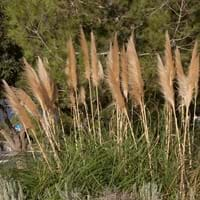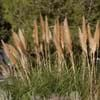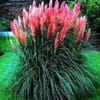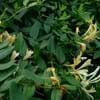Life Span
Perennial
Perennial
Origin
Hybrid origin
Hybrid origin, Mexico, Central America, South America
Types
Karl Feather Reed Grass
Avalanche
Eldorado
Overdam
Not Available
Number of Varieties
Not Available
Habitat
Forest margins, gardens, Grassland, Humid climates
Coastal Regions
USDA Hardiness Zone
5-9
11-15
Sunset Zone
2b, 3a, 3b, 4, 5, 6, 7, 8, 9, 10, 11, 12, 13, 14, 15, 16, 17, 18, 19, 20, 21, 22, 23, 24
A1, A2, A3, H1, H2, 1a, 1b, 2a, 2b, 3a, 3b, 4, 5, 6, 7, 8, 9, 10, 11, 12, 13, 14, 15, 16, 17, 18, 19, 20, 21, 22, 23, 24
Habit
Upright/Erect
Upright/Erect
Flower Color
Light brown
Yellow
Flower Color Modifier
Bicolor
Bicolor
Fruit Color
Non Fruiting Plant
Red
Leaf Color in Spring
Green
Green, Dark Green
Leaf Color in Summer
Light Green
Green, Dark Green
Leaf Color in Fall
Green
Green, Dark Green
Leaf Color in Winter
Gold, Tan
Green, Dark Green
Leaf Shape
Long linear and narrow
Ovate
Plant Season
Summer, Fall, Winter
Spring, Summer, Fall
Sunlight
Full Sun, Partial Sun, Partial shade
Full Sun
Type of Soil
Clay, Loam, Sand
Loam, Sand
The pH of Soil
Acidic, Neutral, Alkaline
Neutral
Soil Drainage
Average
Well drained
Bloom Time
Summer, Late Summer
Indeterminate
Tolerances
Wet Site, Pollution, Salt, Soil Compaction
Drought
Where to Plant?
Ground, Pot
Container, Ground
How to Plant?
Spores
Grafting, Seedlings
Plant Maintenance
Medium
Medium
Watering Requirements
Average Water Needs
Needs more water during establishment
In Summer
Lots of watering
Lots of watering
In Spring
Moderate
Moderate
In Winter
Average Water
Average Water
Soil pH
Acidic, Neutral, Alkaline
Neutral
Soil Type
Clay, Loam, Sand
Loam, Sand
Soil Drainage Capacity
Average
Well drained
Sun Exposure
Full Sun, Partial Sun, Partial shade
Full Sun
Pruning
Prune if you want to improve plant shape, Remove damaged leaves, Remove dead branches, Remove dead leaves
Pinch or prune as they grow to promote branching and bushiness
Fertilizers
All-Purpose Liquid Fertilizer
14-14-14 Fertilizer, Compost
Pests and Diseases
Pests and diseases free
Anthracnose, Aphids, Red blotch, Rust
Plant Tolerance
Drought
Heat Tolerance, Salt and Soil Compaction
Flower Petal Number
Single
Single
Fragrant Bark/Stem
No
Yes
Foliage Texture
Fine
Medium
Foliage Sheen
Glossy
Matte
Attracts
Birds
Aphids, Not Available, Squirrels
Allergy
Skin irritation
Stomach pain, Vomiting
Aesthetic Uses
Not Used For Aesthetic Purpose
Used in parkland
Beauty Benefits
Not Available
Anti-ageing, Blackheads, Reduce Bruises
Environmental Uses
Air purification
Shadow Tree, Soil protection
Medicinal Uses
No Medicinal Use
Dehydration, Diabetes, Diarrhea, Nutrients, Weight loss
Part of Plant Used
Whole plant
Fruits
Other Uses
Not Available
Application in Handicrafts, Food for animals, Showy Purposes
Used As Indoor Plant
No
No
Used As Outdoor Plant
Yes
Yes
Garden Design
Dried Flower / Everlasting, Cutflower, Foundation, Mixed Border, Wildflower
Edible, Herb, Vegetable
Botanical Name
CALAMAGROSTIS x acutiflora
Manilkara zapota
Common Name
Feather Reed Grass
sapodilla , chikoo, Sapota
In German
Feather Reed Grass
Breiapfelbaum
In French
Feather Reed Herbe
Sapotillier
In Spanish
Pluma Reed Hierba
chicle
In Greek
Αστραπή Reed Χόρτο
sapodilla
In Portuguese
Pena Reed grama
sapodilla
In Polish
Pióro Reed trawy
Pigwica właściwa, sapodilla
In Latin
Pluma Grass
sapodilla
Phylum
Not Available
Magnoliophyta
Class
Liliopsida
Magnoliopsida
Family
Poaceae
Sapotaceae
Genus
Calamagrostis
Abelia
Clade
Angiosperms, Commelinids, Monocots
Angiosperms, Asterids, Eudicots
Subfamily
Pooideae
Sapotoideae
Season and Care of Feather Reed Grass and Sapodilla
Season and care of Feather Reed Grass and Sapodilla is important to know. While considering everything about Feather Reed Grass and Sapodilla Care, growing season is an essential factor. Feather Reed Grass season is Summer, Fall and Winter and Sapodilla season is Summer, Fall and Winter. The type of soil for Feather Reed Grass is Clay, Loam, Sand and for Sapodilla is Loam, Sand while the PH of soil for Feather Reed Grass is Acidic, Neutral, Alkaline and for Sapodilla is Neutral.
Feather Reed Grass and Sapodilla Physical Information
Feather Reed Grass and Sapodilla physical information is very important for comparison. Feather Reed Grass height is 60.00 cm and width 60.00 cm whereas Sapodilla height is 150.00 cm and width 60.00 cm. The color specification of Feather Reed Grass and Sapodilla are as follows:
Feather Reed Grass flower color: Light brown
Feather Reed Grass leaf color: Green
Sapodilla flower color: Yellow
- Sapodilla leaf color: Green and Dark Green
Care of Feather Reed Grass and Sapodilla
Care of Feather Reed Grass and Sapodilla include pruning, fertilizers, watering etc. Feather Reed Grass pruning is done Prune if you want to improve plant shape, Remove damaged leaves, Remove dead branches and Remove dead leaves and Sapodilla pruning is done Pinch or prune as they grow to promote branching and bushiness. In summer Feather Reed Grass needs Lots of watering and in winter, it needs Average Water. Whereas, in summer Sapodilla needs Lots of watering and in winter, it needs Average Water.





